How to have a productive kickoff meeting (and empower your team!)

Have you ever been a part of a group project that went nowhere or was badly organized to the point of chaos? Perhaps no one knew who was accountable for what, everyone had a different idea of the goals, or the final results were poor. So, what went wrong?
When it comes to empowering your team to do great work and complete projects, one of the most important things you can do is hold a kickoff meeting.
With a comprehensive project kickoff, you can position your team for success, create alignment and structure, and build resiliency to potential issues. By creating clarity, excitement, and preparedness in this short, focused meeting format, you’re helping ensure your goals are met and that everyone on the team is empowered to do great work.
The question is not, “Should you find the time to run a project kickoff meeting?” but, “Can you afford to leave the success of your project to chance?”
In this guide, we’ll explore how kickoff meetings can fundamentally improve your workflow and how to have an effective project kickoff meeting. We’ll also share tips, activities, and some ready-made templates for a team project kickoff meeting, a multi-stakeholder project kickoff meeting, and an agile kickoff.
Let’s take a look!
What is a project kickoff meeting?
A project kickoff meeting is an initial meeting between all the stakeholders involved in a project and is designed to scope, define and plan a project in order to get it moving.
A project kickoff is used to share a clear understanding of the purpose and goals of the project, organize the team, and set the actions necessary to make it happen.
A good kickoff meeting helps everyone feel excited and clear about what they need to do once they leave the room. You’ll scope out and plan the work involved, figure out dependencies and responsibilities, and answer any questions from the team.
While not everything needs to be 100% confirmed by the end of the meeting, your team should be motivated and prepared to take the first steps necessary to get the ball rolling and make the project successful.
In a nutshell, project kickoff meetings are about alignment, motivation and clarity.
What is the purpose of a kickoff meeting?
A project kickoff meeting aims to give everyone on the team everything they need to steer the project towards success. This means aligning on goals, agreeing on tasks and responsibilities, identifying challenges, and moving forward with the next steps.
During a kickoff, you might also settle any internal disputes, clarify how you want to collaborate and build excitement and team spirit for the project to come!
Not only is the kickoff meeting a chance to share information, but it’s also the best time to motivate and set expectations for future work. This is especially important with a newly formed project team, where you might also break the ice and create team bonds before getting into project specifications.
When people get to know each other better and connect as individuals, this can improve future collaboration and help everyone feel happy and engaged.
In this article, we’ve included three templates for different types of kick-off meetings. One of these is based on experience in large, multi-stakeholder projects, where the kickoff is often also the first opportunity to introduce team members to one another.
In these cases, it’s a good idea to schedule some time for smaller working teams to spend some time together, so new team members can meet and build rapport before the work actually starts.

Your project kickoff is also a great opportunity to surface any challenges or concerns and remove any early obstacles or assumptions. Remember that every project is different, and even when working with an established team, the kickoff is vital to ensure these nuances are addressed.
We often find that things we learned in a previous project should be factored into the next one. The kickoff is a great place to double down on what worked last time, and perhaps try to avoid anything that went wrong too.
Tips for having a successful kickoff meeting
We’ve established that a kickoff meeting can make the difference between a productive project and one that stalls or might even be unsuccessful. But even after you’ve decided to hold a project kickoff, how can you make it successful?
Here are a few ways to set yourself up for success and ensure that you are fully prepared to run your kickoff meeting.
Prepare and consult key stakeholders before the meeting
If you are the project manager, the kickoff meeting should not be the first time you’ve thought about the project at hand. Part of this preparation means liaising with key stakeholders to understand their position, invite them to the meeting, and ensure buy-in on the project.
While you should absolutely open the floor during the meeting, you should already know many of the key details and key figures by this stage. If someone says something that means you cannot proceed with the project at all, something has gone wrong. For example, you should already have spoken to the head of engineering if your product requires input from the product team.
Remember that the goal of the kickoff is to remove any obstacles, set the tone, and get your team moving. Any of the larger logistical concerns and bigger questions of whether a project should go ahead should have been done before the kickoff.
Get the whole project team in the room
Your project kickoff should involve everyone who is directly involved in the project. If someone will be working on the project and collaborating with others to make the project happen, they should be in the room. For those not directly involved, it’s worth asking if they should be in the room. Often, the answer is no. If someone isn’t involved and if it would be a waste of time for them, maybe they don’t need to be there.
While you should keep the larger organization in the loop and provide materials to people outside of the core team, remember that the purpose of the meeting is to position the project for success and get things moving. If someone doesn’t meet that criteria question whether they should be involved. Otherwise, it can be frustrating and unproductive for all parties involved.
Schedule the meeting and test your tech
Set a date and time for the kickoff meeting in advance and let everyone know it’s happening as early as possible. While it’s sometimes difficult to get everyone in the room, be sure to schedule with key stakeholders in mind and try to pick a time that works for the most people.
Send email invites with the date, time, and agenda, and request that all team members confirm their attendance. Be sure to include anything your participants need to prepare and give them the heads-up of what to expect from the kickoff. Prepared teams are more effective teams!
If you’re running an in-person meeting, be sure to book the room and prepare the space for a productive kickoff. This might mean changing the room setup, adding more tables and chairs, or setting up screens.
For virtual meetings, check your tech and set up any online whiteboards or slides you’ll be using. Making sure the kickoff runs smoothly and that you aren’t searching for links or need to spend time setting up elements in your whiteboard can really help things move along productively!
Set a project kickoff meeting agenda
For a successful kickoff that will cover everything and run on time, it’s vital to set an agenda for the facilitator and group to follow. Without a plan, any meeting can become messy and disorganized once you get people in the room. A project kickoff meeting agenda ensures you stay on track and leave the meeting having done everything you needed to do.
Remember that a structured meeting agenda is also a tool for you to use in the meeting. It’s a great way to ensure you stay organized and cover everything without wasting time with off-topic discussions. Where possible, try to include a basic agenda in your invite to the meeting too – it can help everyone arrive at the session prepared to contribute.
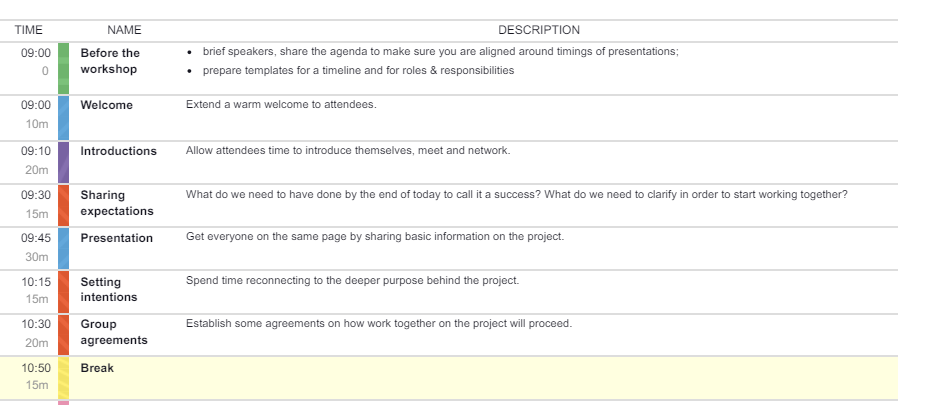
Finally, be sure to keep your meeting agenda focused. The project kickoff is not the place to resolve interdepartmental conflicts or for general company chat. Design your agenda thoughtfully and keep it concise by keeping your objective in mind at all times.
Have a facilitator
Meetings are more effective when there is someone whose job it is to keep things on track and make it a success. Assigning a facilitator can help everyone in the room focus on the content of the meeting, rather than getting distracted by the process or the admin.
For many kickoff meetings, the project manager will also act as facilitator, and lead the first meeting. While this can work, it can also be useful to bring in a neutral party from another department or consider hiring a facilitator.
If your kickoff meeting is a more involved process that requires decision-making and problem-solving, that’s a great candidate for a dedicated facilitator. For more on how facilitators can help and what to keep in mind when hiring one, check out this guide. In any case, be sure to have someone in charge of guiding the group through the process. A free-for-all format rarely results in a great outcome!
Assign a note-taker
In addition to someone leading the meeting, it’s helpful to have someone dedicated to taking notes. In some meetings, it’s possible to have the facilitator also take notes, but in a kickoff meeting, it’s often helpful to separate these roles. Give the facilitator and major stakeholders scope to focus on their tasks by having someone else take notes.
We like to collect our notes for every meeting in Notion. This creates a resource for those who couldn’t attend and ensures nothing vital is missed or forgotten. Collecting insights, summing up key points, and making sure everything is captured can make all the difference for the success of a project. Creating a habit around note-taking during meetings is helpful for subsequent sessions too!
Timebox
Timeboxing has a place in almost all meetings, though it’s especially important during a project kickoff. When it comes to starting a new project, team members are often excited and eager to discuss some aspects in great detail.
While this energy is something you want to encourage, you also need to keep your project kickoff on track. Failing to do so can leave team members unclear about what to do next or you can get lost in the woods and run out of time.
Sometimes, it can be easy for an in-depth conversation about a certain aspect of the project to take over the meeting. While this conversation may be important to have, timebox such discussions and consider tabling more involved topics to follow up on later.
Create a safe container
All workplace collaborations are made better when everyone in a group feels safe and empowered to speak up and contribute. Creating a safe environment in the project kickoff is a great first step to building trust and safety for the project to come.
You might use a team code of conduct or project contact to ensure everyone is on the same page about how to interact. You might also include a brainstorming session as part of the kickoff to facilitate collaboration off the bat. It might even be as simple as making rules and expectations clear to everyone in the meeting.
The steps you need to take to create a safe space are often contextual, though be sure to ask yourself: how can I make it feel psychologically safe to engage in this meeting and the project at large?
Be transparent
Where possible, we find it helpful to be really clear about expectations, timeframe, and responsibilities. If you have a concern or your client has some specific requests, share those with your team and make sure people can access those items after the meeting too. When it comes to divvying up tasks and planning a project, be clear about roles, and responsibilities and have this information readily available.
The more transparent you are during a project kickoff, the more likely you are to spot and solve challenges early in the process. It’s also helpful when it comes to maintaining team motivation and momentum. If people know why they are doing something and why it is important to the project, it’s much easier to feel motivated about doing so.
Include an icebreaker!
Icebreaker games can be an important ingredient for any meeting, especially if those people involved in the project aren’t used to working together. Regardless of how much your team members know each other, be sure to prepare an icebreaker for your project kickoff. This will allow everyone to loosen up, arrive in the space and help them begin to connect.
You can try general icebreaker games, though it can be helpful to design an icebreaker that helps set the stage for the project and connects to your goals. For example, if you’re developing new features to connect with your customers, it can be especially effective to use icebreaker games that focus on people-to-people connection.
If the project kickoff is to include brainstorming or space for ideation, a creative game can be great for getting people in the right mindset! Whatever method you try, remember that this is a vital part of warming up the group and shouldn’t be skipped.
Set clear next steps
Generating momentum early in a project can massively affect its overall success. Often, the first steps after a kickoff meeting can feel tentative or slow. Setting clear follow-up actions with a deadline can ensure that things get done and that the project gets moving.
Once things get rolling, projects and teams are often self-sustaining. Be sure to enable your group to get to work and create momentum with a clear set of actions to take after the meeting is over.
Document outcomes
After the project kickoff meeting is over, project managers need to turn their attention to documenting its outcomes. To ensure project success, you’ll need to have a clear place where to:
- outline the project scope;
- set out project deliverables;
- include a project timeline;
- report on project progress.
This is sometimes called a project charter. Make sure you inform all team members of where they can find this information, and keep it regularly updated as the project progresses.
At SessionLab, we use Notion to detail every project plan, while when running each team kickoff we have a template in Miro we use to collect notes.
What should the project manager include in a kickoff meeting agenda?
Taking the time to structure and plan the agenda for your project kick-off meeting is an important part of making it a success. But how can you ensure you touch on everything you need to without making the meeting a marathon? Our example kickoff meeting agenda below is a great place to start your design process!
You’ll find an explanation of each agenda point that includes some helpful context when it comes to organizing and running your meeting. Let’s take a look at what a typical project kickoff will include.
Meeting setup and outline
Although it may be tempting to jump right into the fine points of project planning, resist the urge and be sure to properly set the stage for your project kickoff. Start by introducing yourself as facilitator, briefly recap the purpose of the meeting, and set any expectations and rules of engagement.
While you should have sent a reminder email before the meeting to cover the purpose of the project kickoff, it’s worth reiterating briefly here what the kickoff is about and why you’re all here. This helps ensure everyone is on the same page and is given an opportunity to fully arrive in the space. If there are any special requirements or tech setup issues take a moment to address them to help ensure your meeting can proceed without issue.
Introductions and check-in
Now you’ve set the stage, it’s time to give everyone a chance to warm up and get to know each other if they don’t already. If you’re working with a team that knows each other well, you might be able to skip introductions, but remember it’s always worth taking the time to check in with the group. Noting any low energy levels or concerns from the group early on can ensure the meeting runs smoothly from start to finish.
With groups that don’t know each other well, it’s a great time to give everyone an opportunity to introduce themselves and touch on what they might bring to the table. Be sure to timebox and facilitate this section so that everyone gets a chance to speak without overrunning or derailing the schedule. The best way to do this? Use an icebreaker game or activity!
Check-In Questions is an effective method for helping a project group get to know one another quickly and warm up for the meeting ahead. Encourage participants to include a sentence or two about what they’ll be bringing to this project and how they feel about the task at hand. Getting a quick read on the room and encouraging some light conversation about expectations is a great way to get started!
Project background
This is where you’ll discuss the impetus for the project you are about to embark on. We often discuss why this project, why now, and what we hope to achieve. Often, big projects have been discussed in various channels before they reach this stage and not everyone has been involved in those conversations. Now is the time to help everyone get on the same page about why the project is important and what brought you to this point.
This might also be your first opportunity to get the team behind the project and start building excitement. This is your chance to help everyone understand the project and to connect with the central vision in a way that means they feel excited to contribute. Sometimes it can be helpful to think of this as an internal pitch to bring your group onboard.
If working with an external client, now would be a great time to give them the floor or present their perspective. Outline your client’s business or product. What is the client’s overall mission, or the company’s brand? What brought the client to pursue this project at this moment in time? Remember this is your chance to make sure your team has a solid grasp of the background of the project and get fired up about it!
Project scope and goals
Discuss the project details and deliverables. What is the purpose of this project? What is the client hoping to achieve? What problems are you trying to solve? What are the goals, as a team and individually? Make sure your team understands the client’s vision for the project, as well as the client’s idea of what a successful project looks like.
It’s also worth carefully outlining the scope of the project. Make it clear where the project ends and what doesn’t fall under the scope of this project. It can be easy for an excited team to have big ideas that fall outside of the reach of the current project.
As your team starts to get an idea of what the project will involve, ensure that the goals for the project are also clear. If the goal of your new feature is designed to help onboard new customers and improve activation, make sure you define what that means.
Getting lost in the woods and trying to solve problems out of the scope of the current project or wholly unrelated to your goal can lead to wasted time and frustrated teams. Align on these items early and help everyone understand where the project ends, as well as where it begins.
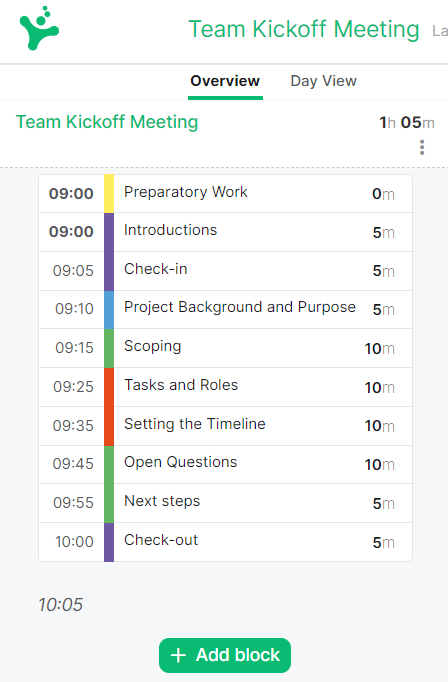
Roles and organization
This is the point to make sure each team member fully understands their role in the project. Assign each person or subteam their tasks, responsibilities, and accountabilities. We’d recommend using one of the various charts or methods to visualize and document the roles and assignments of everyone on the team.
RACI Matrix is an effective framework for not only breaking down the work and roles to be done but to clearly show the various dependencies and reporting systems. If someone isn’t directly involved in conducting groundwork but should be consulted or kept up to speed, this matrix helps ensure that happens.
During this section of the kickoff, every team member should know what is expected of them, who they are working with, and who they should answer to. This is an area that can often get a little messy if not clearly outlined and discussed. You’ll be so glad to have this in writing, especially as roles and dependencies can change and should be kept up to date!
Timeline and major milestones
After setting the main goals of the project and assigning responsibilities, it’s good to set any hard and soft deadlines. Of course, there is an overall deadline for when the project must be completed. But what about the milestones you must reach to ensure the project is proceeding on track?
If the project manager doesn’t yet have those milestones established, now would be a good time to discuss what these look like and when they should be achieved. For example, a large project might have an initial scoping or discovery phase that needs to be conducted before the next stage – it’s important to set a timeline for when this phase is expected to conclude so you can keep the entire project on track.
Decide on a plan that works for everyone and make it concrete. You may also want to schedule follow-up meetings to check in on progress. For example, scheduling a progress meeting every 2-4 weeks for a 3-month project can help ensure that major milestones are hit in time and that any issues are dealt with effectively. Try using a planning method like Who/What/When Matrix to make this process easier!
Questions
At this stage in your kickoff meeting, it’s a great idea to open the floor to questions. You might have briefed team members to come to the meeting with questions, or simply want to open up a general discussion for anything that isn’t yet clear. This is your team’s chance to make sure they are clear on the project brief, what their roles are, and to ask about anything that might prevent them from getting started.
While you might simply have an open discussion, it can also be useful to use a method format designed to help people ask great questions in an efficient manner. For example, Walking questions is a great method to help bridge knowledge gaps and enable the group to start working together on answering open questions immediately.
It’s also worth noting that some important questions relevant to the project may fall outside of the scope of this meeting. While you might not have time to get into deep technical questions here, be sure to set a follow-up or create space in Slack or elsewhere to have these conversations.
As with many aspects of the project kickoff, remember you’re setting the tone for the project to come and so making it safe and easy to ask questions is vital!
Next steps and follow-up actions
With complex projects, it can be so easy to get lost in the big picture and lose sight of what concrete actions need to be taken to get things moving. Before closing the project kickoff, we recommend reiterating your first milestone and ensuring that everyone in the team is clear on the very first actions they need to take once the meeting is over.
Depending on the project, this might mean doing initial research, scheduling follow-up meetings, outlining a prototype or something else entirely. The key is that you can continue the momentum of the kickoff by having everyone clear on what is expected of them and empowered to go do it after the meeting.
In our experience, getting the first steps of a project actioned quickly and efficiently after a kickoff is key to a successful project. Don’t leave the meeting without having everyone clear on what it is they need to do next. Give everyone the tools and clarity they need to get going and take the time to clarify any open questions or uncertainty.
Closing statements and check out
Now everyone on the team has what they need to help bring your project to fruition, it’s time to close the meeting. Reiterate what you expect from your team and ensure that everyone is aligned, but also take the chance to galvanize the group and remind them why you’re embarking on this project. Help everyone leave the meeting excited to get started by having a moment for sharing and reflection.
Try using one of the five simple activities featured in Quick Reviews in 1 minute for a speedy round of sharing and to get a read on how everyone is feeling. Having a moment to share and check out also helps bring the meeting to a symbolic close and clear the decks for the next steps!
A focused checkout activity like One breath feedback is also an effective way of giving everyone a moment to hold the space and give their feedback on both the kickoff and the project at large.
Whichever method you choose, checking out gives everyone who hasn’t yet spoken a chance to be heard and ensures nothing is missed. Try not to skip this step!
Wrap up
Congratulations, you successfully orchestrated a project kick-off and gave your team what they need to get started. But your work isn’t done yet. Review the notes from the meeting, write up any other key points and send a follow-up to the team. Ensure to include any important resources such as the accountability chart and project timeline. Encourage feedback or questions, and include the details of any follow-up meetings or scheduled check-ins.
Whatever format you choose, document everything and make it accessible for everyone who needs it – whether they were present at the project kickoff or not! The more information you share with your team, the less you will have to repeat yourself, and the more empowered and enabled they will be to crack on. Win-win!
Project kickoff templates
If you run more than one project kickoff meeting with the same group of people, you’ll probably want to create a reusable template. SessionLab’s collaboration tools can be quite helpful in keeping your project management neat by allowing you to create and save copies of your agendas in a personal (or team) library.
To get you started, we’ve created three basic templates that cover three types of project kickoff meetings. Whether you are working internally with your own team, in a wide assembly of multiple project stakeholders, or with agile methods, we’ve got you covered.
You can look through these for inspiration or, if you feel they fit your situation, copy-paste them and simply drag-and-drop blocks to customize and adapt each template to your needs.
Team project kickoff
Want to make the design and planning process for your kickoff meeting easy? We’ve prepared a template for a simple, one-hour project kickoff you can use and modify to your needs!
This template is based on our own work here at SessionLab, where we run project kickoffs each new business quarter. Use this template if you are an established team needing to bring clarity and focus to a new team project.
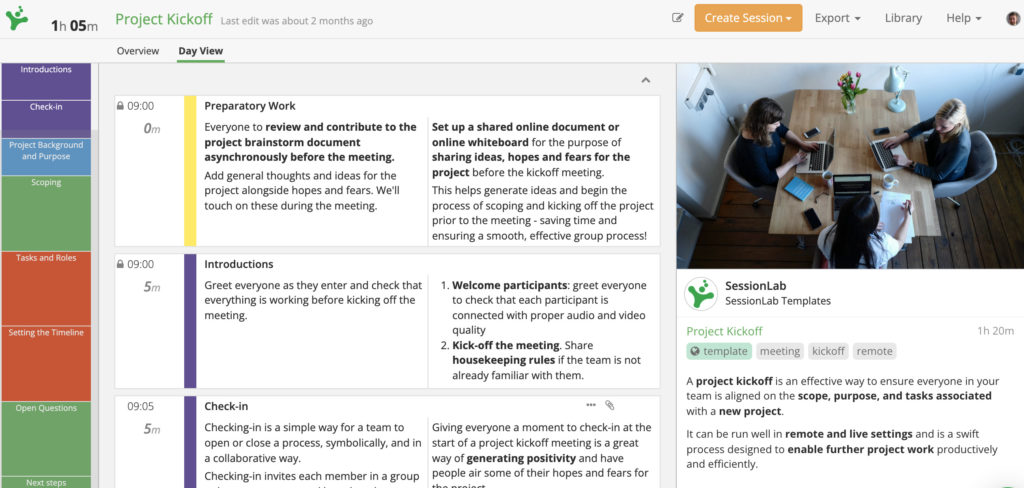
You’ll find everything you need to cover in a simple, adjustable format. While you may wish to use specific activities, lengthen certain sections or introduce elements specific to your project, we hope it makes it easy to get started in a pinch!
Multi-stakeholder project kickoff
Sometimes, a project kickoff is not just for your team members, but will involve multiple groups and stakeholders. Achieving success in such complicated environments can be quite tricky!
In public policy projects, it’s common to have multiple groups and working packages working semi-independently for common goals, detailed in a project plan. In such scenarios, it’s essential to spend time at the start to make sure project goals are shared and understood, background information is understood, as well as to assign responsibilities to different team members to that they may then go on to work with a fair degree of autonomy.
We’ve created this Project Kickoff template based on experience in project kickoff meetings, both online and in-real-life, for large multi-stakeholder public policy projects.
In this template for a half-day meeting you’ll find different sections for sharing agenda items and objectives as well as allowing working groups to spend time together to identify what they need for effective collaboration. Read it for inspiration if you have large projects to kickoff, and take it and adapt it to your needs!
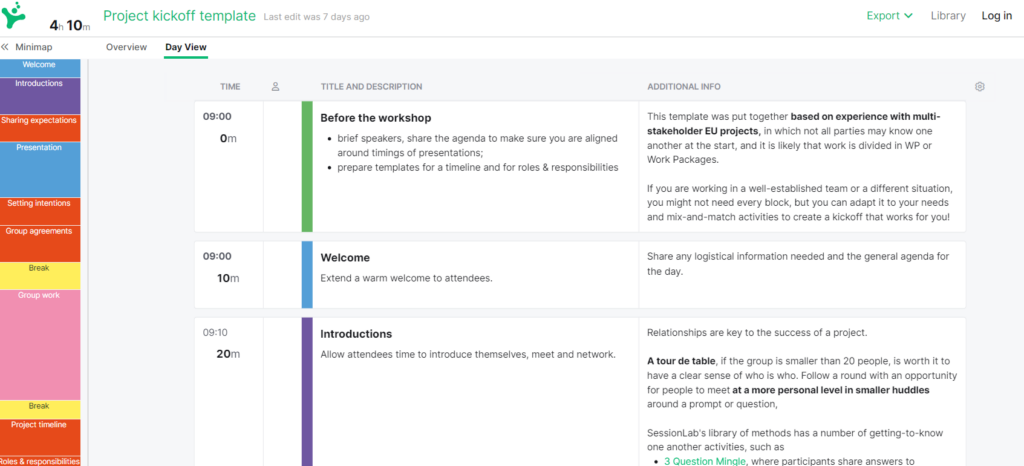
Agile project kickoff
If you are working with Agile you’ll be looking for a dedicated template that fits the format. A kickoff is a short session for the team responsible for developing a solution to understand the objectives, accept them as realistic, and feel empowered and inspired to deliver a solution.
This template has been created considering the DSDM principle Communicate continuously and clearly which underpins the Agile principle of Individuals and interactions over processes and tools. DSDM is an Agile method that focuses on the full project lifecycle, from Kickoff to Close-Out or Retrospective.
Think of an Agile kickoff as a workshop that lays the foundation for effective collaboration. Use it when you need to establish a shared understanding and align team members with their goals, to ensure a successful and productive project.
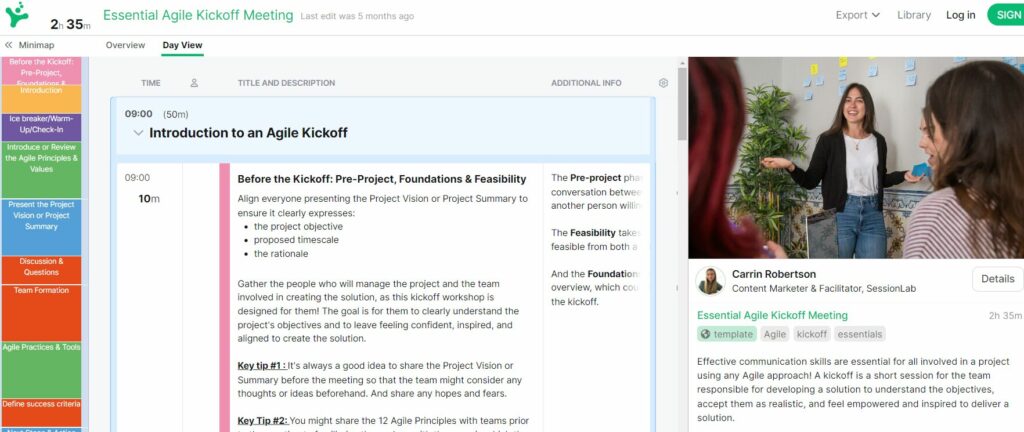
What’s next?
Running a kickoff meeting can feel overwhelming, but the truth is that not running one will result in misalignment and inefficiency that can completely scuttle your project. By following these simple guidelines, your team will feel prepared, excited, and motivated to produce an exceptional project.
To run a good kickoff you don’t just need a good agenda: you also need to approach the task with curiosity, listening, and openness to change the plan depending on your team’s needs. If you feel like you need to refresh your understanding of facilitation skills before running your next kickoff, you might be interested in reading our guide to facilitation skills here.
Have a takeaway from your own kickoff meetings you’d like to share? Is there something missing from our list or have you found something especially useful? We’d love to hear from you in the comments, or in our SessionLab community discussions!
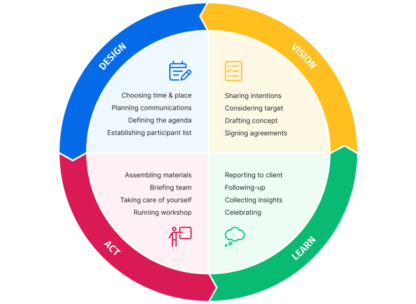

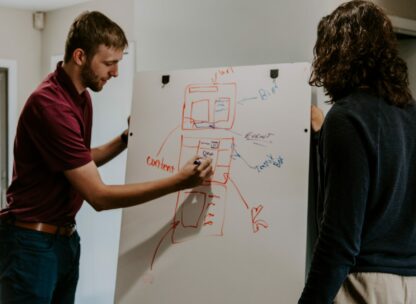
Leave a Comment